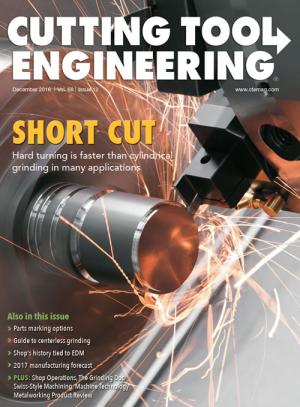EDITOR'S NOTE: Ralf Schürl, who is area sales manager for Schaudt/Mikrosa, of United Grinding, and technical sales support for United Grinding North America Inc., co-authored this report.
Centerless grinding is critical to manufacturing many high-volume automotive components. These include valve spools, control rods, camshafts, crankshafts, pistons, sleeves and rollers. In addition, centerless grinding is applied to produce parts for the hydraulics and fluid control, medical and aerospace industries—indeed, any industry where roundness and extreme accuracy of cylindrical surfaces is needed.
For those “making chips” every day, centerless grinding may seem mysterious, but it’s a fairly straightforward process. This article will discuss how it works, where and when it should be used, and offer advice on how to apply this well-established technology.
The Basics
Before the development of centerless grinding, round parts were either ground between centers or by gripping them with a chuck or fixture. Centerless grinding requires no such workholding methods. Parts are fed between a grinding wheel and a smaller regulating wheel while resting on an angled workpiece support—a blade-like device that sits between the opposing wheels.

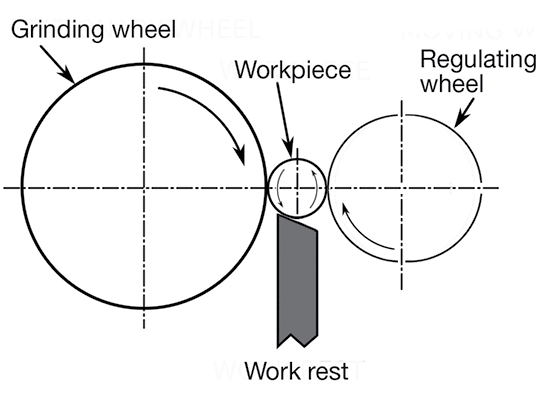
Schematic of a horizontal centerless grinding setup. Illustration by CTE staff.

During grinding, the force of the grinding wheel pushes the workpiece into the regulating wheel and against the support. The regulating wheel determines the workpiece’s rotational speed. Tilt it a few degrees and the workpiece will be pulled through the wheels and out the back of the machine, a technique known as through-feed grinding. Infeed grinding is the second technology available for centerless grinding. The regulating wheel pulls the part against a dead stop placed at the work-rest blade. The grinding wheel, which often contains a profile, is then fed into the part until the final part size is achieved.
There will always be a need for cylindrical grinding, but centerless offers several advantages. Because there’s no need to locate the part between centers or clamp it in a chuck, parts can be loaded quickly into a grinding machine, increasing throughput. The workpiece is securely held between the wheels and support rail, allowing long, thin workpieces to be ground. (Entire lengths of bar stock are often centerlessly ground for use in Swiss-style CNC lathes.) And because the wheel adjustment is diametral as opposed to radial—as is the case with cylindrical grinders—any infeed errors are halved, enhancing precision.
Less grind stock for finishing is generally needed on centerless parts, as the workpiece tends to find its own center upon initial contact with the wheels. Unfortunately, this means concentricity with previously machined holes and other features can be a problem, which is one of the main disadvantages of centerless grinding. Increased setup time is another, because of the need to handle and dial-in large wheels, and special work supports might be required.
The Machine
Centerless grinding machines are often classified according to the inclination of the machine bed. Horizontal-bed machines are the most common, as they provide easy accessibility during wheel dressing. Angular and even vertically inclined beds are used for grinding heavy workpieces because of the potential for a greater grinding force and less abrading of the workpiece by the work support.

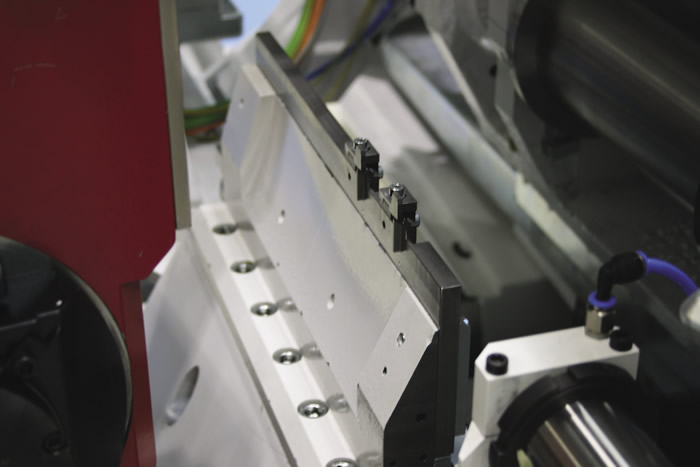
Close-up view of a work-rest dead stop, setup for infeed grinding. All images, except where noted, courtesy Mikrosa.

Some builders classify their machines by the type of grinding zone. With moving-zone, or three-slide, machines, the grinding wheel is fixed during operation and the X-, Z- and B-axis (wheel inclination) movement is controlled from the regulating side. This arrangement provides a compact design and excellent rigidity. Unfortunately, more-frequent adjustment of the work-rest support is required when the grinding wheel wears, although this is easily compensated for because it sits on a separate CNC slide.
Stationary-zone centerless grinders incorporate a stationary or minimally adjustable work-rest support, and the grinding and regulating wheels each ride on their own X- and Z-axis slides.
Cross-slide machines feature a similar axis layout and a fixed-dressing arrangement that maximizes precision and allows fast changeovers due to improved ergonomics, a result of the wheels to be changed moving to the operator. Dual grinding machines deliver a two-step process that combines centerless grinding with grinding between centers, alleviating concentricity concerns.
In the Zone
Regardless of machine design, the workpiece is guided by its outer surface during centerless grinding. Because of this, roundness can be a concern, especially lobing and triangulation. These conditions are sometimes not readily detectable. Using a micrometer or other two-point measurement device may indicate the part is within dimensional tolerance even though it is actually shaped like a cloverleaf.

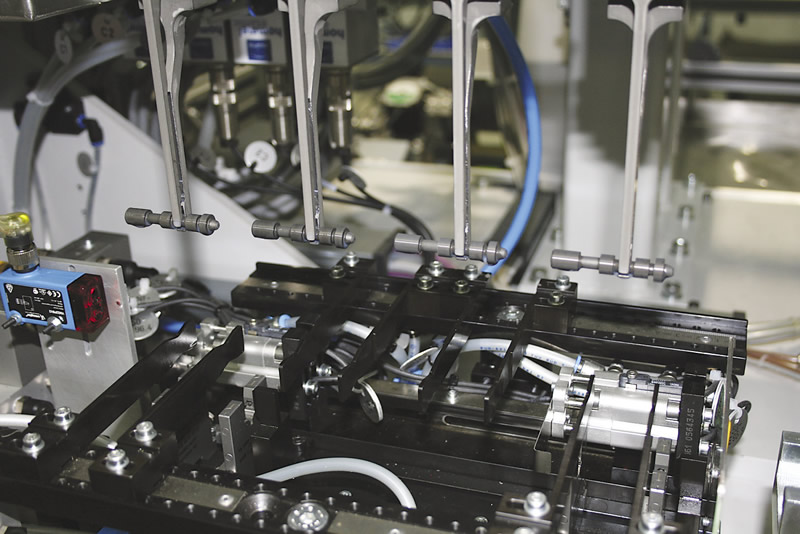
Multiple parts and part features can be ground simultaneously with infeed grinding, increasing throughput.
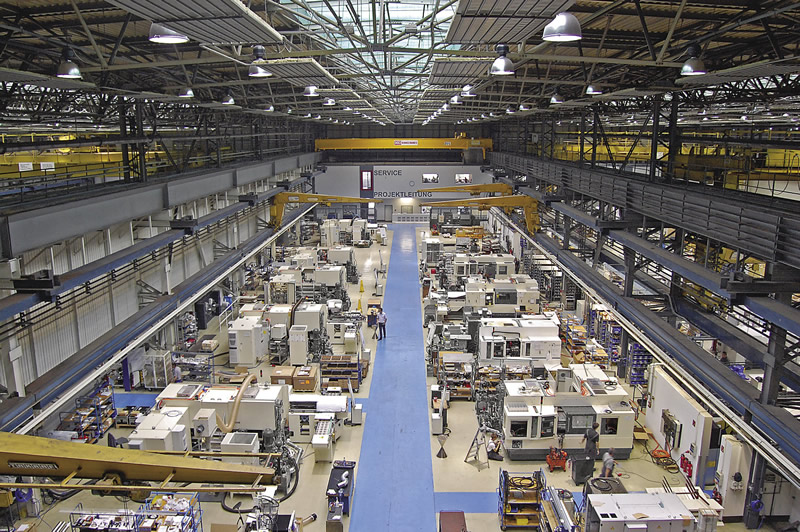
The Mikrosa workshop in Leipzig, Germany, where many models of centerless grinding machines are assembled and tested.

Form errors such as these can be reduced and nearly eliminated via sound knowledge of grinding principles. Adjustment of wheel centerlines and support height, use of proper infeed rates, moderation of wheel forces and dressing methods all have a profound impact on part quality, as do factors such as machine construction and spindle rigidity.
It is only through development of a stable and predictable grinding process that successful results are obtained. For example, increasing the grinding wheel’s rotational speed lowers grinding forces while improving workpiece surface roughness and wheel wear, but also tends to increase heat generation. This may require better lubrication to avoid damaging the workpiece.

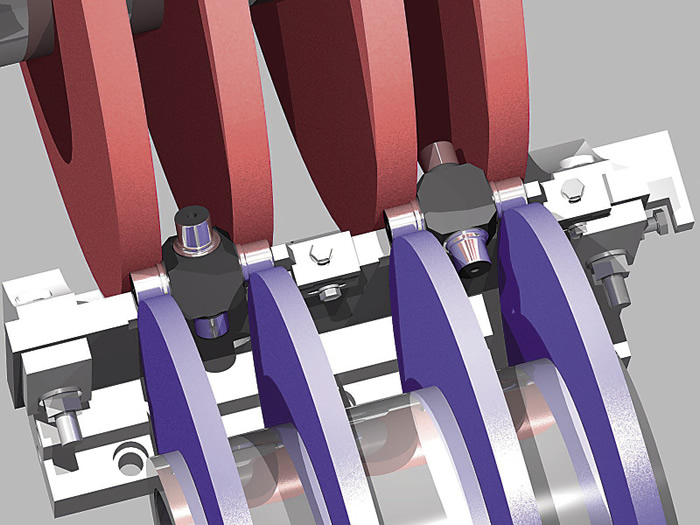
A variety of part shapes and configurations are suitable for centerless grinding, such as automotive U-joint components.

Similarly, the rotational speed of the workpiece might be increased. This reduces heat problems and eliminates roundness errors more quickly, but at the expense of surface finish. Chatter can also be a challenge. As the workpiece changes size during the grinding process, the cutting speed is negatively impacted, a situation that newer machines compensate for by dynamically adjusting wheel speeds.
As with most manufacturing processes, successful centerless grinding requires acquiring extensive knowledge. Optimization occurs only when all of the different factors are accounted for. The mechanisms that affect part quality must be balanced against those of grinding throughput, using a machine tool capable of accuracy and high productivity. Despite these challenges, centerless grinding is a well-understood technology, one that will continue to improve as machine tools and software grow ever more capable.

Capturing Experience
United Grinding’s Ralf Schürl said grinding technology has changed significantly over the past 3 decades, and he is excited about the level of intelligence available on today’s grinding machines.
“One problem with grinding is that it’s still a little bit of a black art,” he said. “I went to a shop recently where there was only one person allowed to set up certain jobs, and he was 65 years old. Think about all the knowledge and experience that will be lost when he retires.”
Mikrosa is working hard to give parts manufacturers a way to capture that knowledge, and, in a few cases, make it less mission-critical. For example, many CNC machines allow customers to enter process information into an onboard database, helping them to visualize whether the rpm is appropriate, or whether chatter is about to become a problem.
“A lot of what we know today was learned over the years through trial and error,” Schürl said. “With the gradual loss of our more-experienced people, it’s important to help those coming behind them by providing as much information as possible so that they have an easier start with this technology.”
There are also functions available, such as automatic wheel dressing and in-process force sensing, that make grinding easier and more predictable. Setup time is another consideration. A machine that once took 6 to 8 hours to changeover can now be done in 90 minutes or less, according to Schürl.
“That’s very fast for a centerless grinder,” he said. “You can push a button and the machine opens up, you load a preset wheel and support runners, and tell the CNC what program to run. That’s it. And dressing the wheel was once a task that was postponed as long as possible. Now you have automatic compensation of the dressing amount, and the machine is on size immediately after dressing, so better process control is easier to achieve. We will never eliminate the need for [operators having] grinding experience, but at least we’ve made it much more intuitive.”
—K. Hanson

Contact Details
Related Glossary Terms
- centerless grinding
centerless grinding
Grinding operation in which the workpiece rests on a knife-edge support, rotates through contact with a regulating or feed wheel and is ground by a grinding wheel. This method allows grinding long, thin parts without steady rests; also lessens taper problems. Opposite of cylindrical grinding. See cylindrical grinding; grinding.
- centers
centers
Cone-shaped pins that support a workpiece by one or two ends during machining. The centers fit into holes drilled in the workpiece ends. Centers that turn with the workpiece are called “live” centers; those that do not are called “dead” centers.
- chatter
chatter
Condition of vibration involving the machine, workpiece and cutting tool. Once this condition arises, it is often self-sustaining until the problem is corrected. Chatter can be identified when lines or grooves appear at regular intervals in the workpiece. These lines or grooves are caused by the teeth of the cutter as they vibrate in and out of the workpiece and their spacing depends on the frequency of vibration.
- chuck
chuck
Workholding device that affixes to a mill, lathe or drill-press spindle. It holds a tool or workpiece by one end, allowing it to be rotated. May also be fitted to the machine table to hold a workpiece. Two or more adjustable jaws actually hold the tool or part. May be actuated manually, pneumatically, hydraulically or electrically. See collet.
- computer numerical control ( CNC)
computer numerical control ( CNC)
Microprocessor-based controller dedicated to a machine tool that permits the creation or modification of parts. Programmed numerical control activates the machine’s servos and spindle drives and controls the various machining operations. See DNC, direct numerical control; NC, numerical control.
- cutting speed
cutting speed
Tangential velocity on the surface of the tool or workpiece at the cutting interface. The formula for cutting speed (sfm) is tool diameter 5 0.26 5 spindle speed (rpm). The formula for feed per tooth (fpt) is table feed (ipm)/number of flutes/spindle speed (rpm). The formula for spindle speed (rpm) is cutting speed (sfm) 5 3.82/tool diameter. The formula for table feed (ipm) is feed per tooth (ftp) 5 number of tool flutes 5 spindle speed (rpm).
- cylindrical grinding
cylindrical grinding
Grinding operation in which the workpiece is rotated around a fixed axis while the grinding wheel is fed into the outside surface in controlled relation to the axis of rotation. The workpiece is usually cylindrical, but it may be tapered or curvilinear in profile. See centerless grinding; grinding.
- dressing
dressing
Removal of undesirable materials from “loaded” grinding wheels using a single- or multi-point diamond or other tool. The process also exposes unused, sharp abrasive points. See loading; truing.
- fixture
fixture
Device, often made in-house, that holds a specific workpiece. See jig; modular fixturing.
- grinding
grinding
Machining operation in which material is removed from the workpiece by a powered abrasive wheel, stone, belt, paste, sheet, compound, slurry, etc. Takes various forms: surface grinding (creates flat and/or squared surfaces); cylindrical grinding (for external cylindrical and tapered shapes, fillets, undercuts, etc.); centerless grinding; chamfering; thread and form grinding; tool and cutter grinding; offhand grinding; lapping and polishing (grinding with extremely fine grits to create ultrasmooth surfaces); honing; and disc grinding.
- grinding machine
grinding machine
Powers a grinding wheel or other abrasive tool for the purpose of removing metal and finishing workpieces to close tolerances. Provides smooth, square, parallel and accurate workpiece surfaces. When ultrasmooth surfaces and finishes on the order of microns are required, lapping and honing machines (precision grinders that run abrasives with extremely fine, uniform grits) are used. In its “finishing” role, the grinder is perhaps the most widely used machine tool. Various styles are available: bench and pedestal grinders for sharpening lathe bits and drills; surface grinders for producing square, parallel, smooth and accurate parts; cylindrical and centerless grinders; center-hole grinders; form grinders; facemill and endmill grinders; gear-cutting grinders; jig grinders; abrasive belt (backstand, swing-frame, belt-roll) grinders; tool and cutter grinders for sharpening and resharpening cutting tools; carbide grinders; hand-held die grinders; and abrasive cutoff saws.
- grinding wheel
grinding wheel
Wheel formed from abrasive material mixed in a suitable matrix. Takes a variety of shapes but falls into two basic categories: one that cuts on its periphery, as in reciprocating grinding, and one that cuts on its side or face, as in tool and cutter grinding.
- micrometer
micrometer
A precision instrument with a spindle moved by a finely threaded screw that is used for measuring thickness and short lengths.
- process control
process control
Method of monitoring a process. Relates to electronic hardware and instrumentation used in automated process control. See in-process gaging, inspection; SPC, statistical process control.
- tolerance
tolerance
Minimum and maximum amount a workpiece dimension is allowed to vary from a set standard and still be acceptable.
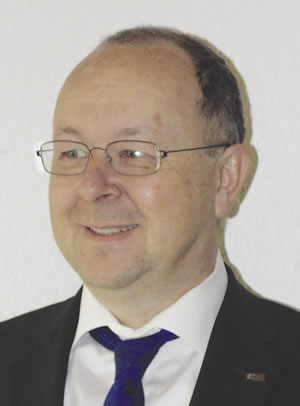 Ralf Schürl, who co-authored this report, is area sales manager for Schaudt/Mikrosa, of United Grinding, and technical sales support for United Grinding North America Inc., Miamisburg, Ohio. For more information about the company’s grinding machines, call (937) 859-1975 or visit www.grinding.com.
Ralf Schürl, who co-authored this report, is area sales manager for Schaudt/Mikrosa, of United Grinding, and technical sales support for United Grinding North America Inc., Miamisburg, Ohio. For more information about the company’s grinding machines, call (937) 859-1975 or visit www.grinding.com.



